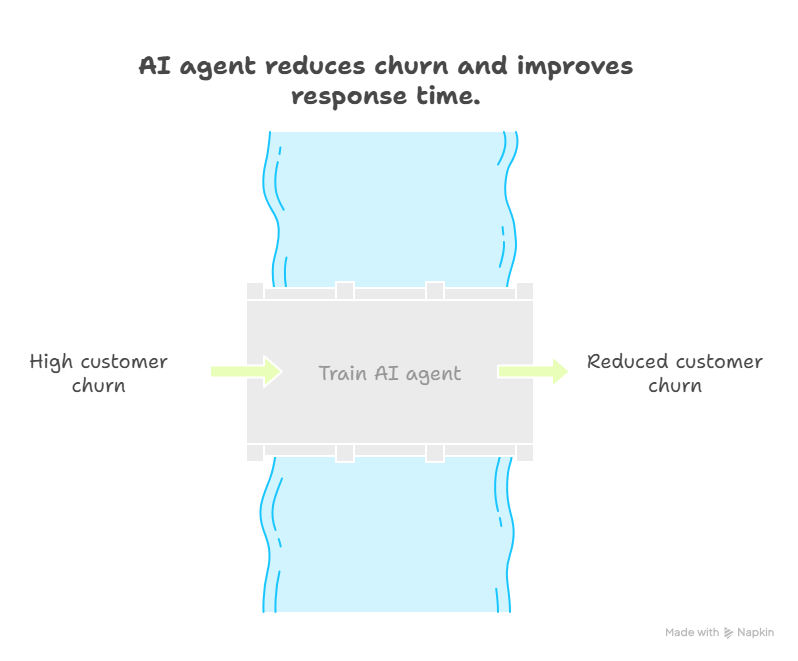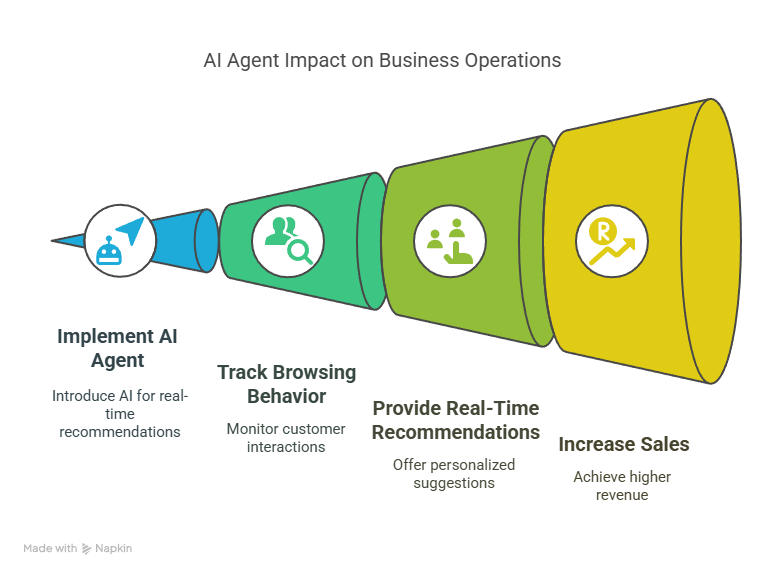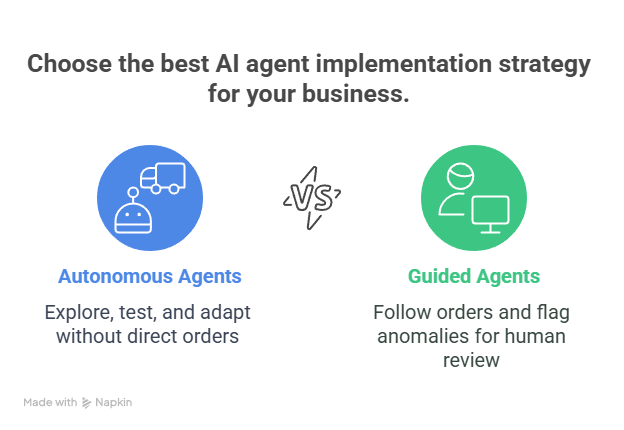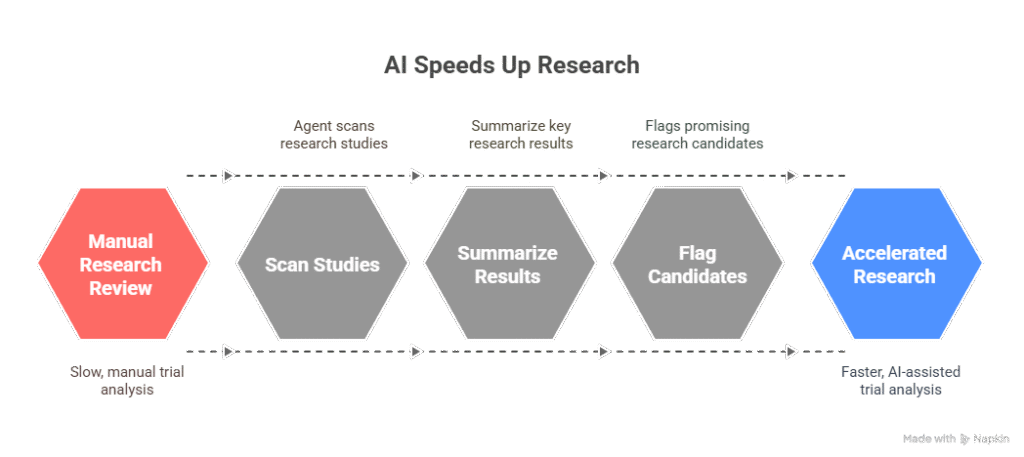Meta Description
AI agents are taking over repetitive tasks in business—from support to logistics—boosting speed, accuracy, and customer experience across industries.
What Are AI Agents and Why Everyone’s Talking About Them
AI agents are smart programs that act on their own to get things done. They’re built with artificial intelligence, meaning they can process data, make decisions, and learn as they go.
Unlike traditional automation tools that follow rules, AI agents can analyze patterns, adapt to new inputs, and interact with users in natural language. This lets them handle real tasks like answering questions, organizing data, or even managing other tools.
Case Study: FinSync Cuts Churn by 30%
Before: FinSync, a SaaS provider, struggled with slow customer support.
Solution: They trained an AI agent using past support tickets. It now handles basic questions instantly.
Result: Response time dropped under 20 seconds and monthly churn fell by 30% .
Real-World Example: AI Nurses Are Real
Mount Sinai Hospital in NYC launched an AI-powered intake assistant. It asks patients about symptoms, evaluates urgency, and guides them to the right department.
Impact: ER wait times fell by 18% and satisfaction scores rose by 12% [2].
Why It Matters: Patients now get help quicker—without waiting for a nurse to pick up the phone.

Quick Tips to Start
- Focus on tasks that repeat every day
- Use data from existing workflows or chats
- Launch small pilots before rolling out to your entire team
- Regularly check how your agent is performing, and update as needed
Making Customer Experience Smarter with AI
Great service isn’t just fast—it’s personal. AI agents can track what users do on your site, figure out what they want, and help before they even ask.
Case Study: NovaLux Increases Sales by 22%
Before: NovaLux used basic product recommendations.
Solution: They added an AI agent that tracks browsing behavior and recommends items in real time.
Result: Sales from product add-ons rose 22% in six weeks [3].
Real-World Example: The Hotel Assistant That Never Sleeps
Hilton and Marriott hotels now use AI concierges in apps and kiosks. You can request towels, check gym hours, or ask for a dinner spot—all without talking to staff.
Impact: Guest wait time dropped to under 30 seconds, and front desk calls fell by 40% [4].

Pro Tips
- Pair your AI with CRM systems so it knows who your customers are
- Use it to remind customers of abandoned carts or expired trials
- Build “if-this-then-that” triggers to create helpful, timely nudges
How AI Agents Help Behind the Scenes
AI agents aren’t just for chat. They can run tasks inside your company, too—from checking invoices to updating records to assigning IT support tickets.
Case Study: LogiBuild Speeds Up Invoicing by 40%
Before: The company took two days to manually check invoices.
Solution: An AI agent now reviews documents, flags mismatches, and routes them to finance.
Result: Processing time cut by 40%, and fewer late payments [5].
Real-World Example: Robots Don’t Just Move—They Think
At JD.com warehouses in China, AI agents assign routes to robots in real time. They react to traffic, order flow, and stock levels.
Impact: Fulfillment time sped up by 35%, and fewer humans needed to oversee operations [6].

How to Use It
- Clean your data first—messy info = confused agents
- Use tools with open APIs so agents can talk to your systems
- Set limits: let them handle the easy stuff, but flag anything weird for a human
Where It’s Going: Autonomous Agents and Self-Driven AI
Thanks to breakthroughs in generative AI and reinforcement learning, some agents don’t just follow orders—they set their own goals. These autonomous agents can explore, test, and adapt without being told every step.
Case Study: BetaHealth Speeds Up Research
Before: Researchers read hundreds of trial results manually.
Solution: A research agent now scans studies, summarizes key results, and flags promising candidates.
Result: Research timelines shrank by 33% [7].

What to Watch Out For
- Try multi-agent systems for complex projects with lots of moving parts
- Run tests in controlled environments before you go live
- Always build in rules for ethics and security
These AI agents are not replacing people—they’re helping teams think faster and focus on the tough stuff.
Final Thoughts
AI agents aren’t the future—they’re now. They’re helping hospitals move faster, warehouses stay efficient, and businesses talk to customers in smarter ways.
They’re also getting better every day. The more they learn, the more useful they become. So don’t wait. Start small, track results, and grow from there. The earlier you start, the sooner your team will benefit.
References
- “Customer Support Trends 2024,” Zendesk, Jan 2024. https://www.zendesk.com/resources
- “AI in Emergency Triage,” Mount Sinai Health System, Apr 2024. https://www.mountsinai.org/news/ai-triage
- “AI-Driven E-Commerce Growth,” McKinsey & Co., Mar 2024. https://www.mckinsey.com/ecommerce-ai
- “Marriott Launches AI Concierge,” Hilton Newsroom, Feb 2024. https://newsroom.hilton.com/ai-concierge
- “Autonomous Business Systems,” Accenture, Feb 2024. https://www.accenture.com/autonomous-systems
- “JD.com AI Warehouse Automation,” JD News, Mar 2024. https://jdcorporate.com/press-release/ai-fulfillment
- “AI in Biomedical Research,” Nature Medicine, Apr 2024. https://www.nature.com/articles/nm2024-ai-research
Tags: AI agents, automation software, business AI tools, customer service AI, generative AI, enterprise workflow, autonomous agents, digital transformation
